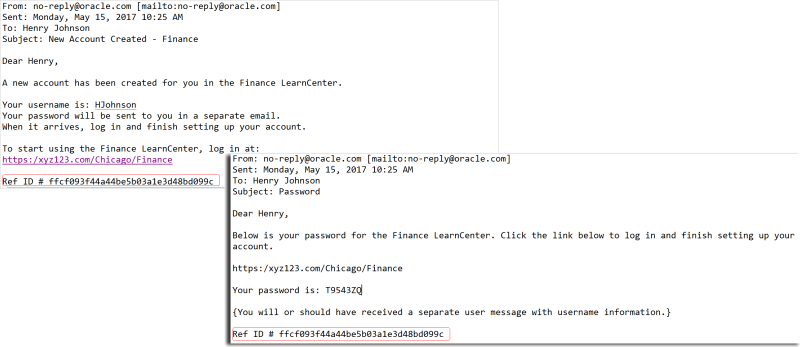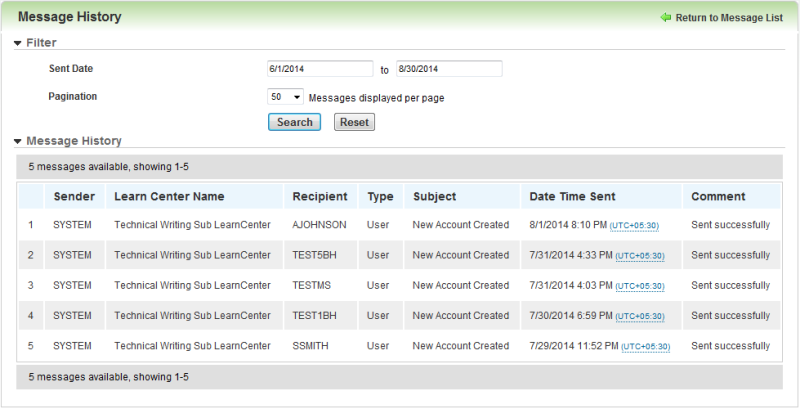 .
.You can automate the sending of account information when you update or create User accounts by using User Communication Messages.
The messages can be sent to Users in the following situations:
Follow the steps below to set up the feature for your LearnCenter.
| Message Name | Recipient | Subject | Message Body | Before/ Upon/ After | Action Date | Configurable by Time Frame | Description | Trigger Available |
|---|---|---|---|---|---|---|---|---|
| Account Updated | User | Account Updated | Dear [[User First Name]] [[User Last Name]], Your account has been updated with following information: Your current log in information is now: Username = [[Username]] Password = Use your current password (If you forgot your password contact administrator to reset) To start using the [[LearnCenter Name]] LearnCenter, log in at: [[LearnCenter URL]] | Upon |
Date Completed
|
No | Sent to Users when their account is updated. | Yes |
| New Account Created | User | New Account Created – [[LearnCenter Name]] | Dear [[User First Name]] [[User Last Name]], A new account has been created for you in [[LearnCenter Name]]. Your User name is: [[Username]] Your password will be sent to you in a separate email. When it arrives, log in and finish setting up your account. To start using the [[LearnCenter Name]], log in at: [[LearnCenter URL]] | Upon | Date Completed | No |
Sent to Users when new accounts are created for them. See Reference IDs below for additional information.
|
No |
| Password | User | Password | Dear [[User First Name]] [[User Last Name]], Below is your password for the [[LearnCenter Name]] LearnCenter. Click the link below to log in and finish setting up your account. [[LearnCenter URL]] Your password is: [[Password]] {You will or should have received a separate User message with Username information.} | Upon | Date Competed | No |
Sent to Users when new accounts are created for them. See Reference IDs below for additional information. |
Default text for all three messages is provided, but you can edit the messages to suit your organization's needs. You have the ability to add custom fields in the Message Subject and Body for all three messages. If you decide after changing a message that you want to restore it to the default setting, click  .
.
See Editing Communication Messages for instructions on customizing these messages.
There are 5 triggers available for the Update Account message. You must add at least one trigger for this message if you make it active. You can then add as many triggers as you need. You also have the ability to make multiple copies of this message.

See Communication Message Automation (Triggers) for instructions on creating triggers for the Account Updated message.
When an Admin creates a new User Account for a LearnCenter, both the New Account Created and the Password Communication Messages are automatically sent to the User. By default, the New Account Created message body contains the User's Username, and the Password message body contains the password. The new account login information is separated into two emails as a security measure to help prevent unauthorized persons from gaining access to a LearnCenter.

There may be instances in which an Admin adds a User to several LearnCenters at the same time, and this causes both messages to be sent to that User multiple times. To help a User to correctly identify the Username and password for each LearnCenter, every set of New Account Created and Password Communication Messages contains a matching reference ID, located at the bottom of the message body. The reference IDs are added automatically by LearnCenter, and they appear in the message body even if only one User Account is created. The reference ID cannot be removed from the Communication Messages.
Message History is available for the User Communication Messages. Rest your pointer over a communication message (or locate the Actions column, depending on your LearnCenter setup) and click  on the Messages page to display the Message History page.
on the Messages page to display the Message History page.

Type in a date range and click Search to display history.

Copyright © 2010-2018, Oracle and/or its affiliates. All rights reserved.